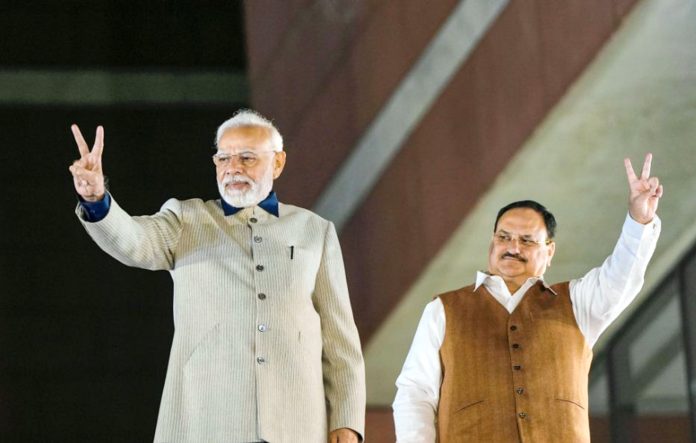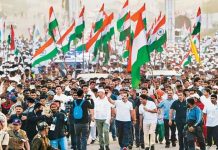By Chanakya
Each Indian state is a microcosm in itself, and among them, Gujarat is possibly the first among equals. Things are different here these days, especially when an election comes to town. This time Gujaratis, cutting across caste, creed and race voted for Narendra Modi and the Bharatiya Janata Party (BJP), to give Chief Minister Bhupendra Patel a victory fit for the history books. His 156-seat win has eclipsed even Congressman Chief Minister Madhavsinh Solanki’s feat. Solanki had won 149 seats in the 1985 Gujarat polls.
How this happened has been discussed ad infinitum across the media and explained in child-friendly terms by political parties as a total dedication of the state to the development and Hiduvta policies of Modi.
It is possibly not as easy as class III arithmetic. First, one must consider that the overall voting percentage for all the 182 seats spread across 33 districts was 64.33%, 4.08% lower than what it was in the 2017 Assembly polls when Gujarat had registered 68.41% voting. So many right-thinking people just did not come out to vote.
The new variable
Secondly, there was a new variable in the mix, making simple arithmetic impossible: The wily Arvind Kejriwal and his Aam Admi Party (AAP). Added to that there was Asaduddin Iwaisi’s All India Majlis-e-Ittehadul Muslimeen (AIMIM). These two were set free to roam across Gijarat with one specific purpose: Cut into Congress votes. AIMIM has been doing this across many states for a while, but this time in Gujarat, it had had a great effect.
Kejriwal, meanwhile, believed in the MCD largesse he has been allowed in Delhi, and went hammer and tongs across Gujarat, again making his tall – and weird – promises of zero electricity charges etc. Kejriwal is a former IITian and a former IRS. It cannot be that he does not understand the sheer financial improbability of his promises. And Gujaratis aren’t that stupid either, to believe a Kejriwal.
Planned and covert
In the end, won 5 seats, but lost deposit on 128 (around 70%). Kejriwal’s foray into Gujarat is being called a ‘misadventure’, but was it? No sensible person, leave alone enterprising Gujaratis, would ever be swayed by promises that stink of blatant lies. Having wasted Delhi’s (to an extent Punjab’s as well) money (unless somebody else had financed this) in Gujarat, Kejriwal’s gains were three-fold. First, he cut deep into Congress vote banks (his main purpose), won over 6% of the votes (12.9%) and earned more than two seats in the state. The last two will enable AAP to claim to be a National Party.


And the Congress factor
The other factor in the BJP landslide was the complete apathy shown by the Congress. Rahul Gandhi walked through the land in his Bharat Yodo Yatra, yet never made any electoral speech, neither did he participate in any electoral organisation.
When the Morbi tragedy happened, Rahul, like a wise, old statesman said this was a human tragedy and he did not wish to bring politics into it. He was praised for this, but Indian politics is a dirty old man, leering, lusty and obscene. This was a god-gifted opportunity for Rahul. He missed it.
Congress wanted to have a door-to-door campaign, and left out all its big guns (whatever the party has). This was a shame. A door-to-door helps when the party has been doing grassroots work for a long while, when its party organisation has helped people in the past. Just because somebody lands up on your doorstep and asks for votes, does not ensure anything. There is no ‘previous experience’ in his CV.
In the end Congress won 17 seats (27.3%).
The BJP story
As for the BJP story, it has been one of astute organisation, complete data collection and hard work. It has been said that Amit Shah spent till 1am every day at the party office, organising strategy. Modi, on the other hand, did rallies galore (he addressed 31), not leaving anything to chance. The Congress, it has been understood, will never learn. Every vanquished learns from the victor, and vice-versa. While the BJP seems to have learnt from history, the Congress has not only forgotten its own history, but has taken no lessons from recent defeats, and even victories. Himachal Pradesh will be a case in point, and if Congress refuses to learn lessons from that hilly state now, the future of the party is bleak.
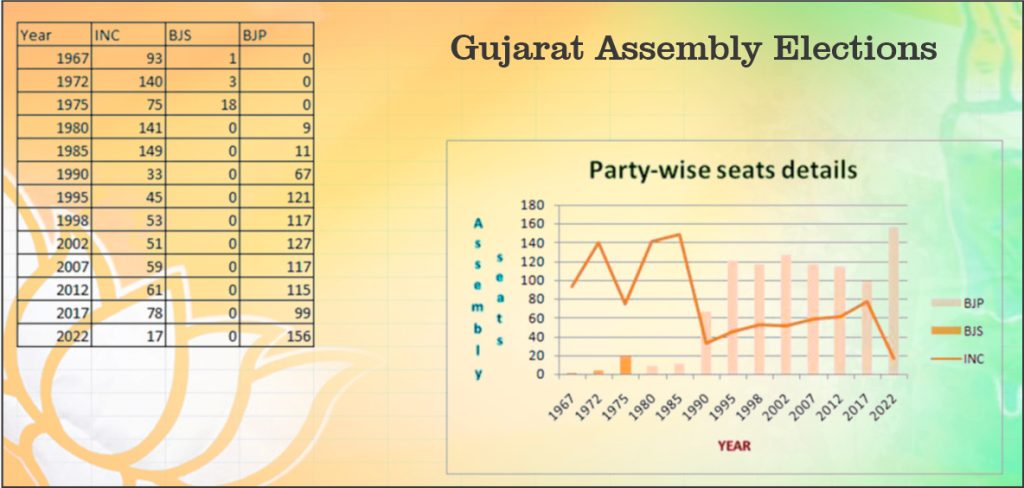

Gujarat won a seventh straight term with a vote share of nearly 53%. The BJP beat its previous best showing of 127 seats in 2002 when Modi was chief minister.
The polls were held in two phases with 89 seats voting on December 1, while the second phase of polling was held on December 5 in 92 Assembly segments.
In his address to BJP workers at the party headquarters in Delhi, after it swept the Gujarat elections, Modi said: “The results of Gujarat have proved how strong is the desire of the common man for a developed India. The message is clear that whenever there is a challenge before the country, people show their faith in BJP.”
Bhupendra Patel was sworn in for a second term as chief minister on December 12. The tenure of 14th Gujarat Legislative Assembly is scheduled to end on 18 February 2023.
The close call in 2017
In the 2017 assembly election, BJP won 99 seats (49.1%), Congress won 77 (41.44%) and 1 seat was won by NCP. Bhartiya Tribal Party and Independent won 2 and 3 seats, respectively.
AAP national convener and Delhi Chief Minister Arvind Kejriwal on Thursday thanked the people of Gujarat for helping his party breach the BJP’s Gujarat “fortress”. He further asserted that though the party has not been able to win too many seats, it at least attained the national party status. He also said that he is hopeful that the party will be winning more seats in the next election.
“I am thankful to the people of Gujarat for helping us attain the status of national party. Very few parties enjoy the status and now we are one of them. Ours is only a 10-year-old party,” he said.
The Bharatiya Janata Party (BJP) has won the Limkheda Assembly seat in Gujarat’s Dahod district where 2002 riots victim Bilkis Bano once lived.
The candidate of the opposition Congress which had promised to revoke the remission granted by the BJP-led state government to 11 convicts in the Bilkis Bano gangrape case ended up third, polling 8,000 votes. Bano was a resident of Randhikpur village in the tribal-dominated Dahod district.
Gujarat Chief Minister Bhupendra Patel on December 8, won a second consecutive victory from the urban constituency of Ghatlodia with a margin of 1.92 lakh.
Gaining 114538 votes BJP’s Kantilal Amrutiya emerged victorious in Gujarat Assembly Elections 2022 from the Morbi assembly constituency and defeated Congress’ Jayantibhai Patel and Pankaj Ransariya from AAP.
The Morbi issue
Morbi drew the nation’s attention to itself after the unfortunate incident of bridge collapse which claimed the lives of 135 people. Out of 182 assembly constituencies, the Morbi seat of Kachh district went to polls on December 1, the first phase of Gujarat assembly elections. BJP candidate and Patidar leader Hardik Patel defeated Amarsinh Thakor of the Aam Aadmi Party in urban Viramgram assembly by 51707 votes.
Cricketer Ravindra Jadeja’s wife Rivaba Jadeja made an impressive debut into electoral politics as she defeated her nearest rival in the Jamnagar North constituency by 53570 votes.
In the 2022 Gujarat assembly polls, the BJP not only gained a record win but also grabbed several seats that it had never won before. These seats include Borsad (Anand district), Jhagadia (Bharuch), Vyara (Tapi), Garbada (Dahod), Mahudha (Kheda).
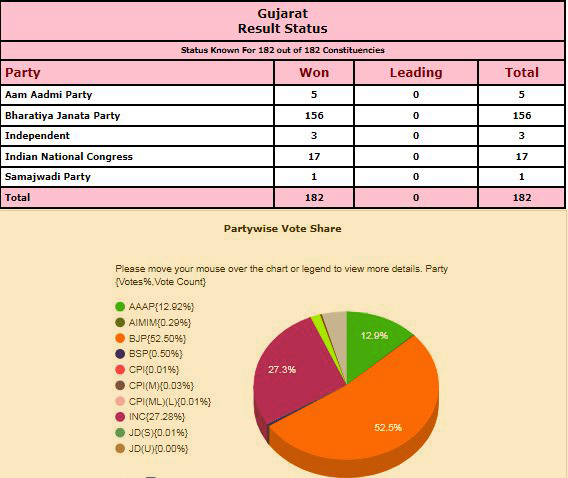

Himachal sticks to change, Congress wins with wafer-thin margin
The Congress again dislodged the BJP from power in Himachal Pradesh, but the party’s victory this time was very thin. Congress had less than 1% more votes than the BJP: it boils down to just 37,974 votes extra
cyclical pattern of change of governments in Himachal Pradesh continued, as the BJP lost its position through a wafer thin vote margin of less than 1%. The fact that the Congress won was, possibly, more because of the BJP’s lack of vision and the lack of ability to rein in its rebels, cutting into the BJP’s vote.
Meanwhile, as the results came to the fore, the typical Co0ngress infighting surfaced as well, with former Chief Minister Virbhadra Singh’s widow Pratibha Singh, former party chief Sukhwinder Singh Sukhu, as well as outgoing CLP leader Mukesh Agnihotri having staked claim. Each sa they have a sizeable number of MLAs’ backing. The issue and the decision, as per tradition was passed to Congress president Mallikarjun Kharge.
In the end Sukhwinder Singh Sukhu got the high command’s nod, probably because he could show more MLAs on his side. He took oath as the 15th chief minister of Himachal Pradesh on December 11. Soon after he was sworn in, the former Congress state chief said: “We have given 10 guarantees and we will implement them. We will give a transparent and honest government. We will implement the Old Pension Scheme (OPS) in the first cabinet meeting.”
Mukesh Agnihotri, leader of the Opposition in the outgoing assembly, also took oath as the deputy chief minister of Himachal Pradesh.
Sukhvinder Singh Sukhu, who came from a humble background but rose through the ranks in the Congress, was chosen as the Chief Minister over the claims of Pratibha Singh and Mukesh Agnihotri – the wife and protégé of Himachal’s six-time Chief Minister Virbhadra Singh, an erstwhile royal. There are expectations that the party will have to do a balancing act by offering Pratibha Singh and her son Vikramaditya Singh key seats in the government or the party.
A wafer thin margin
At the poll, Congress bagged 40 seats with a vote share of 43.9 per cent (18,52,504 votes), while the BJP, with a vote share of 43 per cent (18,14,530 votes), managed to win 25 seats, and the difference of vote share between the two was just 0.9 percentage points, which is lowest since 1951. In fact, the Congress managed to dislodge the BJP from power with just 37,974 votes more. That was close.
The Election Commission announced that the Congress, which was reduced to 21 seats in the 2017 election, surged to win 40 seats, while the BJP got 25 seats – a decrease of 19 seats from the last election. In the 2017 election, the BJP has secured 44 seats. The state assembly has 68 seats.
The BJP has accepted defeat graciously, with Prime Minister Narendra Modi saying: “I want to thank the Election Commission for conducting elections peacefully. As far as I know, re-polling in any poll booth was not required. I also want to thank the voters of Himachal. The difference between the number of votes for BJP and Congress was less than 1%.” Interestingly, while addressing an election rally two days before the Himachal Pradesh assembly polls on November 12, Modi had urged the people to change the rivaaz (custom) of alternately voting for the BJP and the Congress, saying it has hurt the state.
If it is any consolation, Chief Minister Jai Ram Thakur won his seat with an impressive margin, getting almost 76% of the votes.
The disruptor
The Aam Admi Party (AAP), the anti-Congress disruptor, mostly acting on behalf of another party, contested 67 seats and lost deposit in all. A candidate must secure at least one-sixth or 16.7 per cent of the total valid votes cast in a constituency to save the deposit.
AAP never had any realistic chance of winning in this state, yet left its candidates to cut Congress votes. That did not work out well for Arvind Kejriwal’s party, 24 candidates losing even to NOTA votes. The party managed to secure above 1,000 votes in only 14 seats. On 52 seats, AAP could not secure even one per cent vote share. So far, AAP has performed worst in Garget and Barsar, where it managed to get only 139 and 148 votes. As per ECI website, AAP has managed to secure only 1.1 per cent of votes in the state.
High turnout
Himachal recorded a 75.6% voter turnout. The state’s last voter turnout was 75.57% in the election of 2017. The total population of the state is over 7.32 million. The highest polling of 72.35 per cent was registered in the Sirmour district followed by 68.48 per cent voting registered in the Solan district and 67.67 per cent in the Una district. During the election, the Shillai district registered the highest 77 per cent polling while the Sarkaghat district registered the lowest.
How did the BJP fall?
Apart from the citizens’ penchant for changing governments in every cycle, two other issues possibly went against the BJP. The first was the Old Pension-New Pension issue and the second was the votes pulled out by BJP rebels. There was also the issue of factionalism, a rare issue within this party.
BJP had rebel candidates on 21 of the 68 seats. The BJP lost at least nine seats where the rebels contested. Two of the rebels won. First is Hoshiyar Singh from Dehra, who left the BJP after not getting a ticket. He won by some 14,000 votes. The other is KL Thakur, who won from Nalagarh.
Another example is Indora, where the Congress’s Malender Rajan won. The BJP rebel here, Manohar Dhiman, took 4,422 votes, taking away from what the BJP would have got had he not rebelled. Adding to the rebel problem was three factions at play in the BJP. One was led by Nadda, another by Anurag Thakur, and the third by Chief Minister Jairam Thakur.
Congress infighting
The fight for the top post in Himachal Congress was witnessed on the roads on December 9, after the supporters of two rival camps – led by Pratibha Singh and Sukhwinder Singh Sukhu – indulged in a show of strength. The two leaders have now openly announced their desire to be the next chief minister of the state.
Nearly a dozen Congress MLAs were seen at Virbhadra Singh’s Holly Lodge home in Shimla. The supporters of his widow Pratibha Singh reached the Chaura Maidan area of the city and began shouting slogans in favour of the party’s state chief and her husband, Virbhadra Singh. They even tried to stop the vehicles of observers, including that of Chhattisgarh Chief Minister Bhupesh Baghel, and sloganeered demanding Singh be made the next chief minister.
Pratibha Singh’s camp claimed they have the support of 15 MLAs, while Thakur Sukhwinder Singh Shuku’s team said they have the support of 21, they said, adding that four MLAs support neither.
A day after wresting power in Himachal Pradesh, newly elected Congress MLAs on December 9, passed a typical one-line resolution authorising party president Mallikarjun Kharge to name their chief minister.
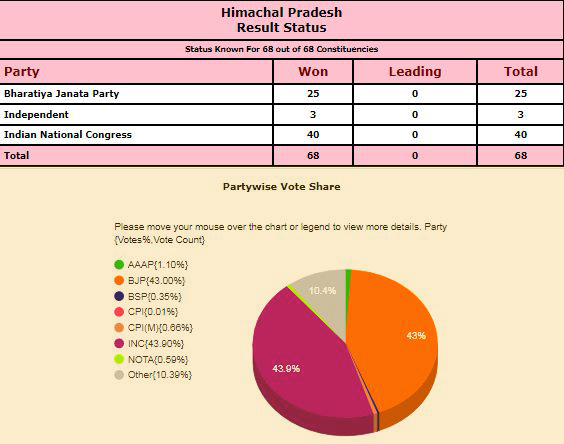

The pension schemes
The promise of restarting the old pension scheme spurred the Congress campaign as a large chunk of the population is in government jobs. The BJP made a “double engine” pitch, implying that having the same party in power at the Centre and in the state guarantees development on all fronts. But the Congress insisted that local issues matter most. (see box on right).
History of alternatives: Governments from 1985
Since the 1985 assembly elections, neither the BJP nor the Congress has had the chance to stay in power for a second time. This time, too, the BJP did not succeed in changing that custom.
- In the 1985 Election, INC won 58 seats (55.46%) and BJP got 7 seats (30.61%).Virbhadra Singh elected as CM
- In 1990 Assembly Election BJP won in 46 seats(41.78%) and INC won in 9 seats(36.54%).BJP’s Shanta Kumar was appointed as the Chief Minister of Himachal Pradesh for his second term.
- In 1993 Assembly Election, The Indian National Congress won 52 seats(48.2%) and a majority of seats and its leader, Virbhadra Singh was appointed as the Chief Minister of Himachal Pradesh for his second term.BJP won 8(36.4%).The number of constituencies was set as 68 by the recommendation of the Delimitation Commission of India.
- 1998 Assembly Election The Indian National Congress and the Bharatiya Janata Party won an equal number of seats, but the BJP managed to form the government by allying with the Himachal Vikas Congress, and Prem Kumar Dhumal was appointed as the Chief Minister of Himachal Pradesh. The number of constituencies was set as 68 by the recommendation of the Delimitation Commission of India.
- In 2003 Assembly Election INC won in 43 seats(41.00%) and BJP won in 16 seats(35.38%).Virbhadra Singh was reappointed as the Chief Minister of Himachal Pradesh for his third term.
- In the 2007 Assembly Election BJP won in 41 seats(43.78%) and INC won in 23 seats(38.9%). Prem Kumar Dhumal was reappointed as the Chief Minister of Himachal Pradesh.
- 2012 Assembly Election INC won in 43 seats(42.81%) and INC won in 26 seats(38.42%).Virbhadra Singh was reappointed as the Chief Minister of Himachal Pradesh for his fourth term.
- In 2017 Assembly Election BJP Won 44 seats(48.79%) and INC won 21 seats(41.68%). Himachal Pradesh Chief Minister Jairam Thakur was an accidental chief minister. Though the BJP won the assembly election in 2017, its CM face Prem Kumar Dhumal lost his own Sujanpur seat. The party then picked Thakur, then a five-time winner from Seraj in Mandi district.

